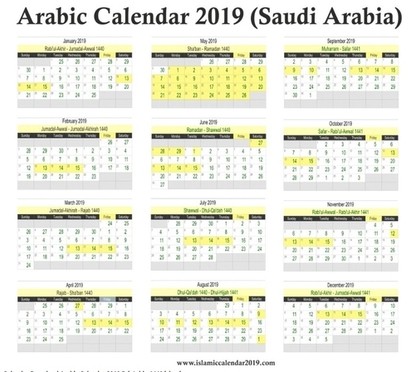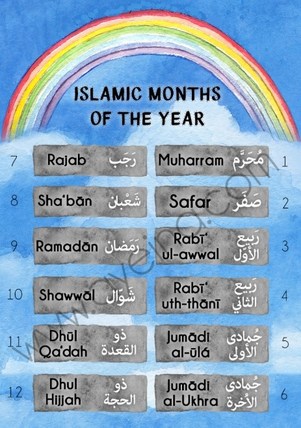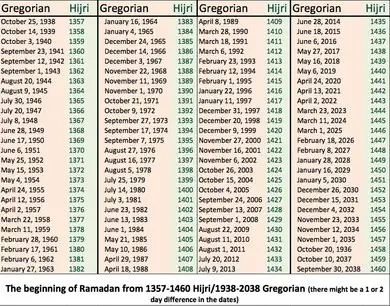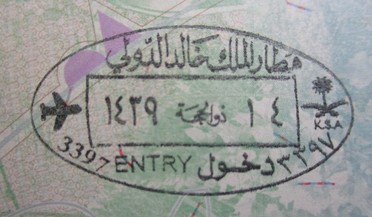In Saudi Arabia, people follow two calenders- the Hijri (Islamic) calendar and the Gregorian (Western). And because of this fact, I used to earn 11 days more pay than equivalent workers in the rest of the world because my salary was calculated according to the Hijri calendar which is 11 days shorter than the Gregorian. Sadly for me on 1st October 2016, all that changed.

So, why do Saudi Arabia and the Muslim world follow the Hijri (Islamic) calendar? The answer is that the Hijri calendar is hugely beneficial to Muslims. In the Quran, Chapter 2, Verse 189, Allah orders all Muslims to use the phases of the (new) moon to mark the fixed periods of the affairs of people including the Hajj annual pilgrimage. Muslims obey Allah’s orders and since the Hijri calendar is 11 days less, unlike the fixed Gregorian year, such scheduled events will naturally fall into different seasons in a cycle of 33 years.
The wisdom of Allah’s (SWT) words means for example that every Muslim in any part of the world will experience the fasting of Ramadhan equally during any one of the four seasons during the 33-year cycle where in summer, the fasting day is long and hard, in winter it is short and easy and in spring and autumn the fasting day length will be only average.
The Hijri (Islamic) calendar is of great benefit to Muslims in regard to their personal and religious lives since the Hajj pilgrimage will happen during all of the four seasons. Also, Ramadhan fasting and the Eid celebrations will also occur in different seasons throughout the year.
Does the change to the Gregorian calendar mean the end of the Hijri calendar in KSA?

No! Since 1932, all government worker salaries in Saudi Arabia have been calculated and paid according to the Hijri (Islamic) calendar. The fact that a Hijri year is about 354/355 days long, (a lunar year) meant these workers were being paid 11 days more in their salaries per year than workers in countries using the normal Gregorian calendar (solar) year of 366.25 days.
However, on 1st Oct 2016 and in order to save money, the Saudi government stopped using the Hijri calendar to pay salaries and decided to use the Gregorian which in effect, brings them in line with employees in the kingdom’s private sector and the rest of the world.
But the change was made for work purposes only. The Hijri calendar is still very much alive and in use today in public life. It is still used for planning and scheduling most public, social, personal and religious events. We all know the months of the Gregorian calendar from January through to December, but what exactly are the months of the Hijri calendar?
The Hijri (Islamic) months, their meanings and events

The Hijri calendar began in the Christian year 622 CE. It is called the Hijri calendar because it marks the year that Mohammed (SAW) and the early Muslims made Hijra or migration from Mecca to Medina.
The names and meanings of the Hijri months come from pre-Islamic times when the calendar was fixed according to the seasons. After the Quran was revealed, a prohibition was imposed on fixing the months with the seasons. Also, both a number of religious events and meanings were ascribed to them.
When referring to a Gregorian month in English, we say the name of the month, for example, January, February. March etc but in referring to the Hijri in the Arabic language only a number is used, for example, for the month of Muharram we say Month 1 and Month 2 for the month of Safar etc.
Here is a list of the months with meanings and fixed events.
| No | Name | Meaning | Events |
| 1 | Muharram | Prohibited Fighting Forbidden | Islamic New Year (1st) Day of Ashura (10th) |
| 2 | Safar | Empty/Void | |
| 3 | Rabi Al Awal | 1st Spring | Birth of Mohammed (SAW) (12th) |
| 4 | Rabi Al Thani | 2nd Spring | |
| 5 | Jumada Al Awal | 1st of Parched Land | |
| 6 | Jumada Al Thani | Last of Parched Land | |
| 7 | Rajab | Respect/Honour Fighting Forbidden | Isra & Mi’raj (27th) |
| 8 | Shaaban | Scattered/ In between | |
| 9 | Ramadhan | Excessive heat/ burning | Fasting Month / Eid Al Fitr Layet Al Qadr (Odd night of last 10 days) |
| 10 | Shawaal | Raised | |
| 11 | Duhul Al Qadah | Truce/Prohibited Fighting Forbidden | |
| 12 | Duhul Al Hijja | Pilgrimage Fighting Forbidden | Hajj (8-13th) Day of Arafa (9th) Eid Al Adha Feast (10th) |
Same as the Gregorian, the Hijri (Islamic) calendar has 12 months, but since the Hijri is about 11 days less in length, the days of the months of both calendars only coincide precisely every 33 lunar years.

Why is each of the Hijri months between 29 and 30 days long?
Quran 2:189 stipulates that each new moon should mark the first day of each of the new months 1-12 listed above. On average a new moon occurs every 29 days, 12 hours, 44 minutes and 3 seconds. So each Islamic month is either 29 or 30 days long. If the Hilal or crescent moon is sighted on the last day of each month, the new moon cycle begins the following day and that day becomes the first day of the new month.
Each new moon must be sighted by human witnesses so mathematical calculations and a fixed calendar are not valid measurements.
Why can’t Muslims just insert an extra month (13) to keep the Hijri calendar in line with the Gregorian?

In Quran 9:36-37, Allah strictly forbids changing the months from the prescribed 12. The result is that because it is 11 days less, the Hijri calendar falls behind the Gregorian calendar each year and in time, the months of both calendars only coincide once again after 33 lunar years. This is equal to only 32 solar years.
Note that the Hijri new year does not start on January 1st. This is because it is 11 days shorter than the Gregorian. A Hijri year will usually fall into two, even three successive Gregorian years because of the annual 11 shortfalls.
How do you convert dates from the Gregorian calendar to the Hijri calendar and visa versa?

You can convert Hijri to Gregorian instantly and visa versa using an online conversion program available at https://www.islamicfinder.org/islamic-date-converter/
In usage, I notice that the date converter does not always give the precise converted date since the days of the human sighting of the new moons will differ from the calculated astronomical calendar called the Umm al-Qura calendar used for administration and planning.
The Islamic date converter can be accessed online, embedded into a website or used as a tablet/phone app.
Which countries and organizations use the Hijri calendar?

on 14 Duhul Al Hija, 1439/2018
- Turkey
- Saudi Arabia
- Kuwait
- Islamic Society of North America
- Iran
- Afghanistan
Turkey uses the Turkish Lunar Calander calculated up to the year 1444 H /2022 AD. Saudi Arabia and the Islamic Society of North America use the Um Al Qura calendar based on actual new moon sightings together with an astronomically calculated Islamic calendar used for administrative purposes. Microsoft uses the Kuwaiti special algorithm to calculate Islamic dates similar to a Tabular Islamic Calendar. Iran and Afghanistan use a Solar Hijri calendar with dates beginning in 622 AD/CE from the year of Mohammed (SAW) migration from Mecca to Medinah.
Related Questions?
Can the Hijri lunar calendar be used for agricultural purposes? The ideal calendar for farming should follow the seasons and be able to keep close track of the times for plowing, planting, maintaining and harvesting crops. Since the Hijri calendar takes no heed of the seasons it is not the best for agricultural purposes.
What is a Tabular Islamic Calendar? It is a Hijri calendar based on arithmetical rules rather than human sightings of the moon or even astronomical calculations. (Um Al Qura). It is used to predict the times of the positions of the planets, sun and moon. In this calendar, 30 days are assigned to the odd months. 29 are assigned to the even-numbered months, except during a leap year when 30 days are given to the 12th month Dhuhul Al Hija.
